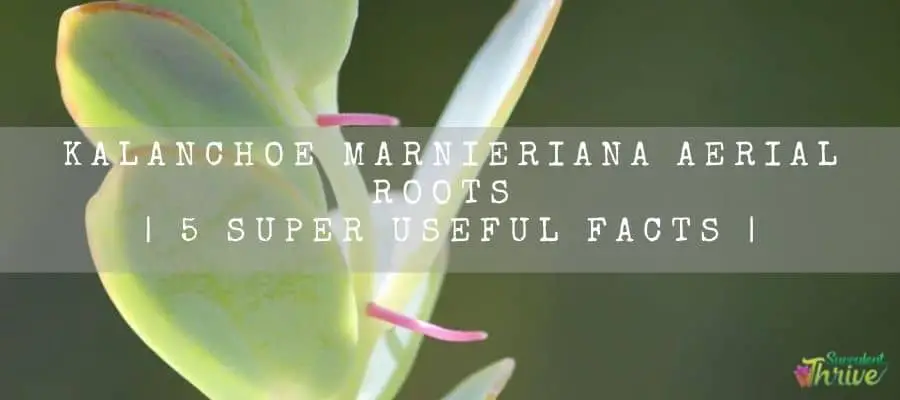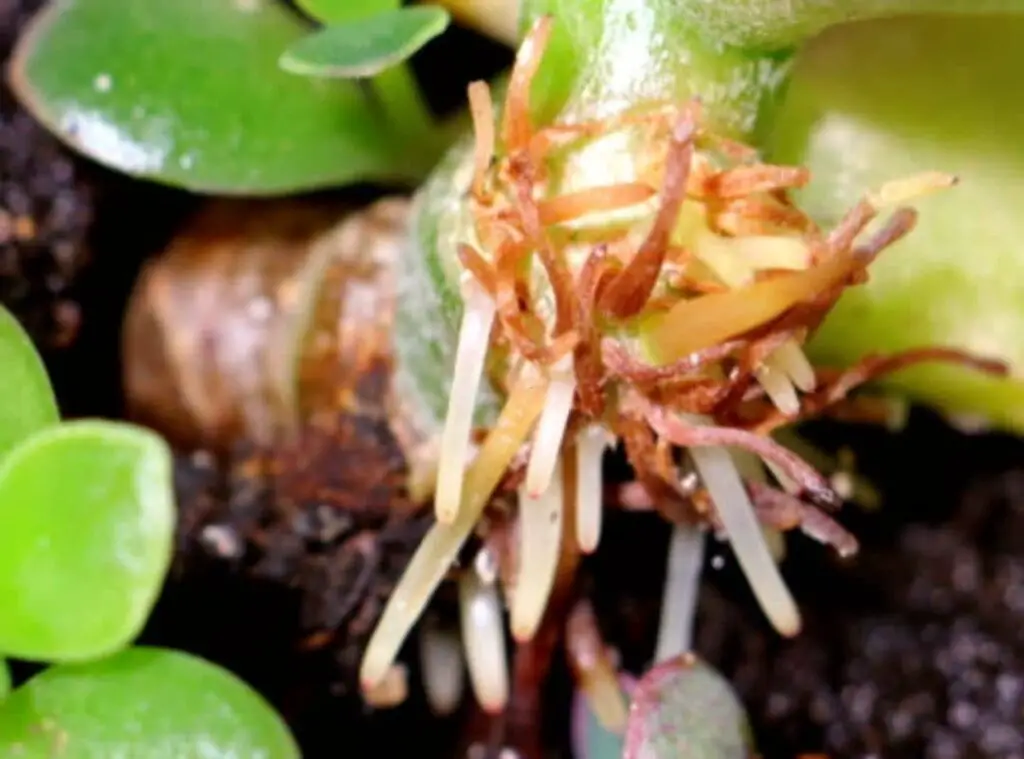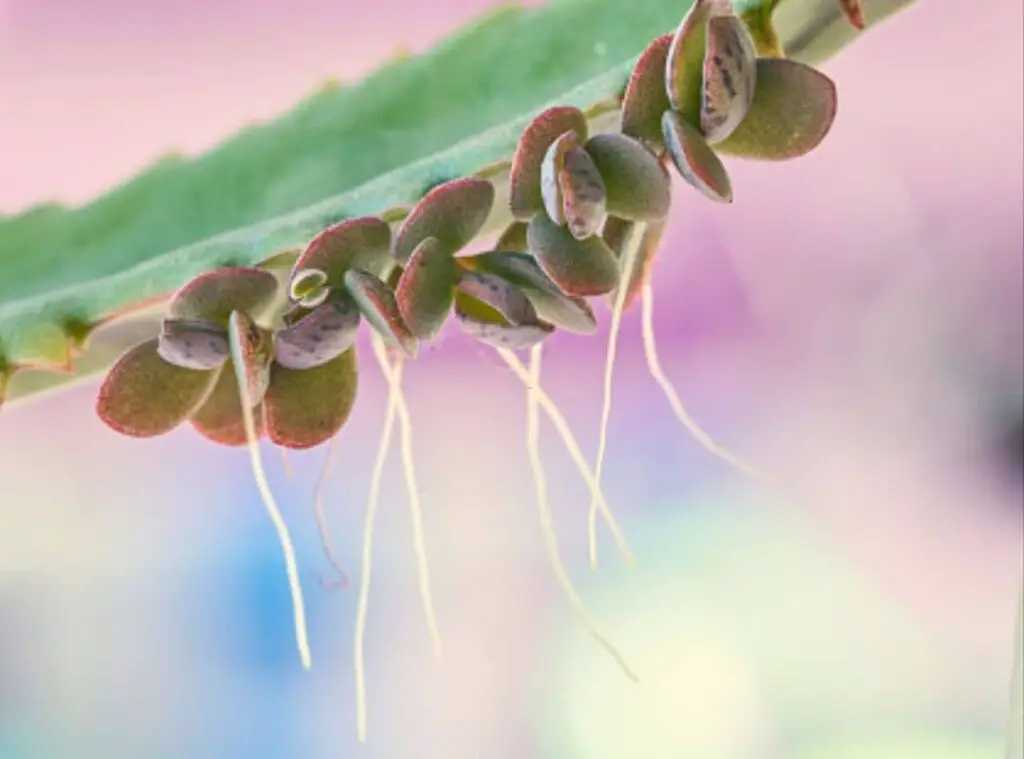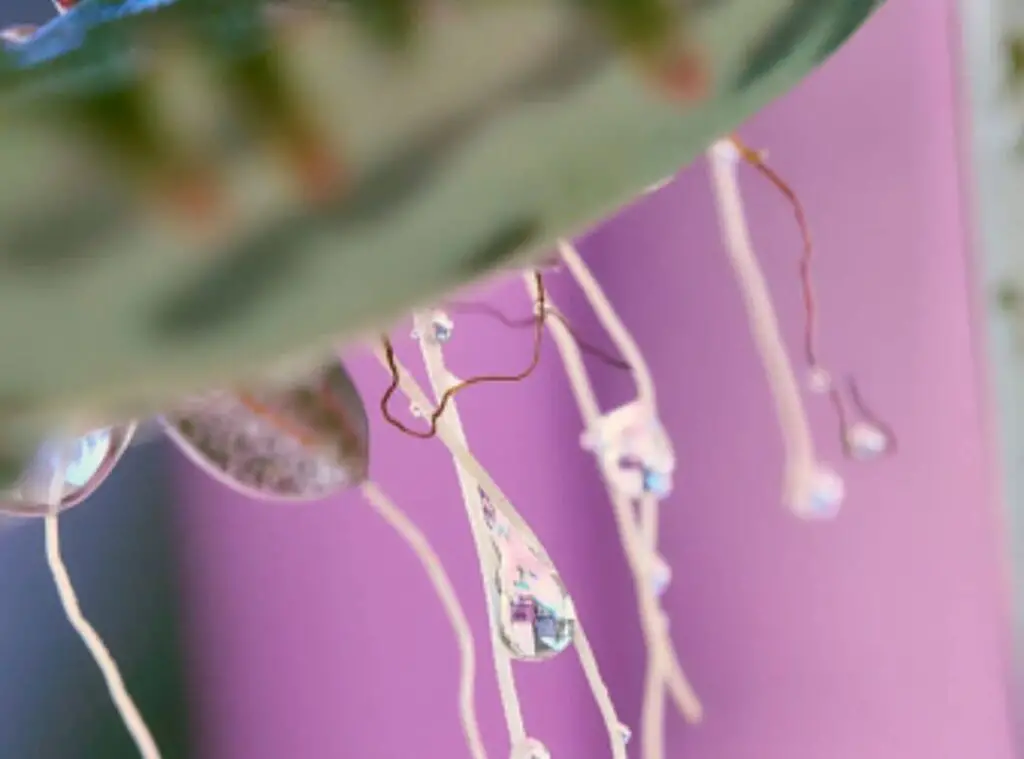You can see Kalanchoe marnieriana aerial roots during most of the year. You could also identify the aerial roots by their appearance.
Usually, they tend to root thoroughly and faster whilst laying out on top of the dirt. You could usually spot them either in pink or in white.
Once Kalanchoe marnieriana form more aerial roots, that would give these plants a bushy appearance. However, it will not be in a pretty way. However, when they get older, it will make the plant look ugly.

What are Kalanchoe marnieriana aerial roots?
As aforesaid, Kalanchoe marnieriana aerial roots are a root type which would grow on the stem reaching towards the air while forming above the soil surface.
These succulents would form aerial roots and the reasons to develop the aerial roots are as follows.
Kalanchoe marnieriana Aerial roots could absorb water from the air – This is quite possible to happen especially in places which have high humidity conditions.
Once they form aerial roots, they could absorb water from the air instead of gaining water from the soil. However, they cannot absorb water from the air as fast as they do from the regular soil. In addition to that, once Kalanchoe marnieriana aerial roots get older in age, water absorbing pace would be even less.
The reason for that is, their root hairs tend to drop or could perish once the plant gets older. That makes them slower the rate they absorb moisture from the air.
In addition to water and moisture absorbing from the air, they could also absorb the nutrients from the air too.
Having said that, it is very rare that they can absorb the essential and usable nutrients from the air. These plants cannot use gas as their nutrients source.
The only possible way of absorbing the nutrients would be absorbing those from the water vapors or water droplets which are carrying these. However, those will also be very insignificant quantities.
Aerial roots could take in fresh air for the plants. It is essential for the plants to have air which consists of both oxygen and carbon dioxide.
However, since this is a succulent type, these kalanchoe plants could perform a process called photosynthesis.
They could also provide some structural support for these plants. consider that your plant is running out of adequate sunlight.
As a result of that, they tend to stretch out and bend towards a direction where they can absorb sunlight. You could call this process Etiolation. Once this condition takes place, it will give the plant a shaky condition. Moreover, chances are that they could get taller.
In this circumstance, aerial roots would be helpful since those would be beneficial in giving a stable position for the plant.

Why do kalanchoe marnieriana grow aerial roots?
Kalanchoe plants tend to make aerial roots if they have a shortage of sufficient water storage. It could be frequently spotted when those plants are in a humid environment too.
As such they would tend to produce aerial roots and absorb water from the air using those.
Therefore, it is vital that you water these succulents properly, so that they do not have to develop aerial roots and look for moisture. When they form aerial roots, they want to indicate that you are not fulfilling its requirement in water.
Lack of light
Kalanchoe plants tend to produce aerial roots if they lack enough sunlight. Once they do not get sufficient sunlight, they tend to become taller.
Furthermore, they would become stretchy and leggy in appearance as well. They literally bend towards a direction where they could absorb enough sunlight and you could call this condition as Etiolation.
Once they reach this condition, there is a high potential for them to develop aerial roots.
They do not intend to get more light by developing those aerial roots as there is not even any chlorophyll available.
They develop aerial roots as they become heavy and since they expect they will fall on the ground soon. In case if they fall over on the ground, those aerial roots will make them grow on the ground in a striking position.
They would further be able to make a firm base as well. As such, it is crucial that you supply it with adequate sunlight so that it does not have to produce aerial roots.
If it is not possible for you to provide adequate sunlight, you should supplement them with a grow light and provide them with artificial sunlight.
Air humidity
There is a high potential for the Kalanchoe plants to produce aerial roots, if there is a lot of water in the air.
In other words, if the surrounding air is high on humidity levels that would make the kalanchoe plants produce aerial roots.
It is quite common that many succulents could grow to their best potential once you grow them in dry and arid weather conditions.
Kalanchoe marnieriana is not different to them and they require the same conditions to thrive well.
Humidity interrupts the water evaporation process and they would make the soil stay in soggy and wet conditions for too long once you water them.
As such, make sure that you do the necessary to safeguard the plant from these high humid conditions. You could try placing a fan as it will solve this issue to some extent as it would help for a better air circulation.
Watering
If you did not water the succulent adequately, chances are that they would produce aerial roots to absorb more water.
That is a way of responding to the lack of water storage and that is an early indication they send out to you to rectify this issue.
As mentioned, aforesaid, they could absorb water from the air. If you spot your succulent appear to be in a shriveling look and if you spot aerial roots forming, you need to adjust your watering pattern.
You need to adjust watering depending on the seasons, light conditions and on the temperature levels as well. As such you need to decide when you have to enhance watering and when you have to decrease watering.
For example, you need to water the kalanchoe plants if you have kept them in intense sunny and dry conditions.

What should I do with Kalanchoe Marnieriana aerial roots?
You should remove the aerial roots of kalanchoe marnieriana plants as they would make the plant look ugly once those roots get older.
On the other hand, you do not have to worry about them, when they are fresh as they would be pink in color, and it is kind of attractive to watch them.
Having said that, once you spot them developing the aerial roots, you need to make sure that you provide it with more light and increase in watering as well.
Forming aerial roots is an indication the kalanchoe plant gives to tell that you need to adjust your care treatments.
This is sort of an early indication which they give, and you need to act faster so that you could avoid further worsened repercussions.
Can you plant kalanchoe marnieriana aerial roots ?
You could plant aerial roots of Kalanchoe marnieriana. The aerial roots which are laying on the ground would make more roots and it is an interesting feature of the kalanchoe marnieriana plants.
Best is to trim them just below the new growth of the roots. After that you could go ahead and pot them back up and you could see them forming more stems.
Should you remove Kalanchoe Marnieriana aerial roots from ?
You should remove the aerial roots of kalanchoe marnieriana plants as they would make the plant look ugly once those roots get older.
On the other hand, you do not have to worry about them, when they are fresh as they would be pink in color, and it is kind of attractive to watch them.
You could use equipment such as trimmers, fingernail clippers etc. for this purpose, however, make sure that they are all clean and sterilized though.
If the aerial roots are too old, you could scrape them while using a credit card. This is easy to get rid of as they could fall off very easily and will not harm the plant as well.

Conclusion
Usually, aerial roots are formed if a succulent is running out of water. Moreover, it is quite often to spot them forming aerial roots if the plant is in a humid environment as they form aerial roots to absorb the water from the air.
Aerial roots do not form in the soil. Instead, they develop in the air forming above the soil whilst striking towards the air just like their name defines them.
They could also absorb moisture and would be helpful when we grow them in the soil too.
Read Next: Kalanchoe Marnieriana Care | Ultimate Guide To Proper Care |
